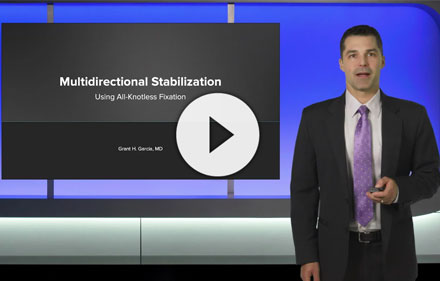Multi-Directional Instability Stabilization

Multidirectional Instability
Overview
Shoulder instability happens for a few different reasons. It can happen after a traumatic shoulder dislocation if the shoulder doesn’t heal properly. Recurrent instability can also happen due to a naturally loose shoulder. In this case, the soft tissues (labrum and capsule) are repeatedly stretched and can no longer provide support or stabilization to the shoulder.
When a shoulder is unstable, a patient may feel like the shoulder is slipping out of its socket and feels weak. These instability events are sometimes painful, but not always.
MDI Stabilization Testimonial
FAQs
What are the treatment options?
Initially, shoulder instability can be treated conservatively: rest, activity modification, physical therapy, and possibly using anti-inflammatory medication for pain and soreness.
Physical Therapy: All patients are advised to try physical therapy as a first step. The goal is to strengthen muscles that support the shoulder joint, including the essential rotator cuff muscles. Strong muscles help fortify tendons, ligaments, and cartilage so they can hold the components of your shoulder joint in place across a range of motions.
Studies show that patients who are conscientious about following a physical therapy program for at least six months have a 90% success rate in reducing or eliminating pain caused by shoulder multidirectional instability.
Giving physical therapy a try is important for all sufferers, as data shows that surgery cannot fully restore stability in an estimated 20 to 30% of patients. An experienced orthopaedic surgeon, such as Dr. GrantGarcia, can help explain options and possible outcomes based on data and experience.
When should surgery be considered?
If the stability of your shoulder does not improve, the next step is evaluation by a physician to determine the best treatment plan. For chronic instability-such as repeated shoulder dislocations-a capsulorrhaphy may be the best option. A capsulorrhaphy is a surgical procedure that repairs and tightens the shoulder capsule (the connective tissue around the shoulder) to help stabilize the ball and socket.
Is a capsulorrhaphy procedure appropriate for athletes?
Professional athletes need to weigh the benefits and risks of this solution, because increased shoulder stability is achieved at the expense of range of motion. After surgical recovery, the average loss of motion is about 10 degrees with external rotation. If you’re not a professional pitcher, this likely will not matter to you.
Case Presentation of Patient with MDI
Surgical Options
Capsulorrhaphy
Initial Multidirectional Instability Treatment
A capsulorrhaphy is a surgical procedure that repairs and tightens the shoulder capsule, (the connective tissue around the shoulder) to help stabilize the ball and socket. The procedure tightens the essential ligaments that provide stability to the shoulder joint. It does so by wrapping the joint in a tight capsule of ligaments, tendons and cartilage.
The procedure can be done arthroscopically or with open surgery. When the technique is performed as open surgery, it is called Extensive Inferior Capsular Release and Imbrication. An arthroscopic capsulorrhaphy is a minimally invasive procedure done through small incisions. One incision is used for a tiny camera (arthroscope), while the others are used to insert surgical tools and instruments that are used for the repair. The capsule surrounding the entire shoulder is repaired using a construct of small sutures, which then tighten the capsule by being anchored down to the glenoid bone.
Surgical Recovery
Following surgery, you’ll be sent home in a special brace called a Gunslinger. This unique brace immobilizes the shoulder and will need to be worn for six weeks as the tissue around the joint heals. Dr. Garcia will give you specific instructions for post-op pain management.
After six weeks, your shoulder will likely be strong enough to begin a course of light exercise therapy. Expect to diligently stick to your physical therapy routine for at least six months. Your rehabilitation will focus on healing the subscapularis muscle properly, as it has been cut during surgery. Approximate recovery time is six months and this surgery has a high satisfaction rate overall.
For more information about shoulder multidirectional instability, please request an appointment with experienced Sport/Shoulder orthopaedic surgeon Dr. Grant Garcia. Call or email our office today to schedule your visit.



















